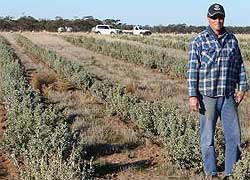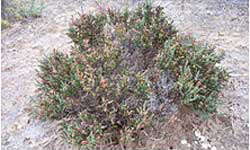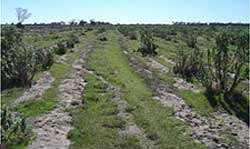Saltbush for saline land
 Saltbush is a native, salt-tolerant forage. It is most suited to warm climates with low rainfall such as northern and central Victoria. It can be used to rehabilitate salt-affected soils — Class 2 (moderate) and Class 3 (severe) that do not waterlog.
Saltbush is a native, salt-tolerant forage. It is most suited to warm climates with low rainfall such as northern and central Victoria. It can be used to rehabilitate salt-affected soils — Class 2 (moderate) and Class 3 (severe) that do not waterlog.
The most commonly used species are:
- Old Man Saltbush (Atriplex nummularia)
- River Saltbush (Atriplex amnicola).
Old Man Saltbush is suited to well-drained areas and is relatively frost hardy. River Saltbush is more palatable and tolerant of slightly wetter areas.
Neither type is suitable for areas dominated by Samphire, which is an indicator of:
- high levels of salinity
- water logging
- conditions too wet for saltbush to persist.
Saltbush requires a combination of both warm temperatures (>25°C) and moderate moisture for its growth, so it is less suited to most areas in southern Victoria.
With good management, saltbush can be a productive part of a grazing enterprise. Stands on less-saline areas can provide an opportunity to increase productivity by including inter-row species, such as medics. Land class or saline zone fencing to provide effective livestock control is a key to the success of saline rehabilitation with saltbush.
How saltbush works
Land clearing following European settlement has caused the water table to rise across much of northern Victoria.
In areas where water tables are within 2m of the surface, moisture can rise to the surface and evaporate — concentrating salts at the surface. The salt kills salt-sensitive vegetation. Salt-tolerant plants such as Sea Barley Grass dominate the area. Increasing levels of salts cause patches of bare ground known as scalds.
Saltbush stops this process by:
- using moisture from deeper in the soil profile
- lowering the water table
- disrupting the upward movement of moisture.
Winter rainfall then leaches salts into the soil. The top soil becomes less saline and can support more salt-sensitive forage plants, such as medics.
Hostile and reclaimable sites
 Hostile sites:
Hostile sites:
- have high levels of salinity
- generally have a patchy cover of Sea Barley Grass, with scalds exceeding 1m2 (Class 3 salinity)
- they tend to occur when the rainfall is less than 400mm
- are on heavy soils, such as clays and clay loams.
These sites can be planted to saltbush primarily, with an optimum plant density of 2000 stems/ha or more.
 Reclaimable sites:
Reclaimable sites:
- have moderate levels of salinity
- generally have a thick cover of Sea Barley Grass with scalds less than 1 m2 (Class 2 salinity)
- tend to occur in the 400-600mm rainfall zone
- are on lighter soils, such as sands and sandy loams.
These sites should be planted to widely spaced rows of saltbush at a density of up to 1500 stems/ha.
 On reclaimable sites, the areas between the rows of saltbush can be sown to moderately salt-tolerant forage. Plant species such as Tall Wheat Grass, Puccinellia and a salt-tolerant cultivar of Yellow Burr Medic (Medicago polymorpha cv Scimiter). Then fertilise with phosphate fertiliser. Saltbush will also benefit from fertiliser.
On reclaimable sites, the areas between the rows of saltbush can be sown to moderately salt-tolerant forage. Plant species such as Tall Wheat Grass, Puccinellia and a salt-tolerant cultivar of Yellow Burr Medic (Medicago polymorpha cv Scimiter). Then fertilise with phosphate fertiliser. Saltbush will also benefit from fertiliser.
Samphire and dash is a native species that indicates conditions are likely to be too wet for saltbush to survive. Areas dominated by samphire should be fenced separately to minimise damage by livestock.
 Establishment of saltbush
Establishment of saltbush
Saltbush can be established by direct seeding or planting nursery stock. Direct seeding requires exact and prescriptive conditions to minimise the risk of failure. Planting nursery stock is more expensive, but also more reliable. Both forms of establishment require good preparation to minimise the risk of failure.
The site should be spraytopped in the spring prior to planting, then ripped and mounded during summer to provide a seedbed. After autumn and early winter rains have leached salts out of the mounds, weeds should be sprayed and the seedlings planted in late winter or spring.
Grazing and management
Fencing to control livestock is the single most important tool for the management of saline discharge areas and saltbush plantations. Samphire zones should be fenced to exclude livestock altogether. Saltbush needs to be fenced so that livestock can be made to strategically graze the stands.
The first grazing of a new stand:
- can promote multiple stems and bushy growth
- should only occur after the saltbush is firmly anchored to the soil by its roots
This may be as early as eight months, but is generally 12 to 18 months after planting. Grazing must be closely monitored to ensure plant stems are not seriously damaged while they are young and fresh. Let livestock remove up to 80% of the leaves.
Mature saltbush requires grazing once or twice a year to remain productive. Saltbush must be grazed hard to promote fresh growth.
Autumn is the most common time to graze saltbush. The combination of understorey with saltbush can raise the total feed value to a maintenance level. The stand can also be grazed in spring if productive species are planted between rows.
Saltbush leaves have a high salt concentration (up to 30% of dry weight). Sheep can only consume up to 200 grams of salt per day. They cannot eat enough saltbush to maintain weight. A productive pasture between the saltbush rows means stock can eat more and maintain weight. Supplementary feeding is required in saltbush stands without any inter-row pasture.
Livestock grazing saltbush must have access to fresh water.
Of the many varieties available, Old Man Saltbush is the most suitable for planting in saline discharge areas, it is:
- deep-rooted
- tolerant of high salinity levels
- tolerant of low rainfall
- should be productive for 10-20 years
- can survive for up to 50 years.
Suitability of saltbush
Area landscape | Suitability |
|---|---|
Target area is in northern Victoria and experiences long hot summers | Suitable |
Target area is Class 2 and 3 salinity (sea barley grass and bare patches) | Suitable |
Surface soil only occasionally appears moist in summer | Suitable |
Occasional samphire plants are present | Suitable for River Saltbush |
Surface soil often appears moist in summer | Not suitable |
Native species dominate the area | Not suitable |
Target area is dominated by Samphire | Not suitable |
References
- Barrett-Lennard E.G. (2003) Saltland Pastures in Australia. A Practical Guide. Second Edition. Land and Water Australia, Canberra, Australia
Further information
- Dept of Primary Industries and Regional development (2019). Saltbushes for dryland salinity management.
- Dept of Primary Industries and Regional development (2019). Establishing saltbush and understorey for dryland salinity management.
- Saltland Solutions — options for saltland restoration, Land and Water Australia 2009.